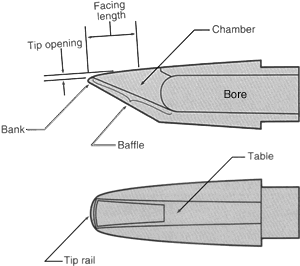Mouthpiece Anatomy 101
With such a bewildering array of clarinet and saxophone mouthpieces available, its hard to know what to choose. Here's a quick guide to clarinet and saxophone mouthpiece construction and terminology.

Tip Opening
Wider tip openings offer a freer "blow" and can be played more loudly. However, they are brighter in sound and require more control. Conversely, narrower tip openings offer more resistance to airflow and require a less control. They tend to have a darker and rounder sound.
Baffle Height and Chamber Profile
The baffle is the roof of the mouthpiece chamber. A “high baffle” is when the baffle is built into the tone chamber, thereby reducing the chamber’ size. A high baffle gives a tone with more edge and brightness. Conversely, a “low baffle” results in a larger chamber and a somewhat darker sound.
Bore
Mouthpieces with a small bore give a tighter, more compact, focused sound. They are more individualistic (soloistic) in nature and therefore are better suited for solo playing than for use in ensemble playing. Large bore mouthpieces have a broad and open sound quality and blend well in ensemble situations.
Material
Student mouthpieces are usually made of plastic. They are made to be strong and are molded to precise dimensions for uniformity of specification.
Professional mouthpieces are generally made from Ebonite (hard rubber) or metal, although other materials such as crystal are sometimes used.
Metal mouthpieces tend to vibrate more quickely than ebonite, giving a brighter, more projected sound.
Other Important Terms
- Table: the flat surface that the reed is placed upon.
- Window: the hole in the mouthpiece between the tip rail and table.
- Side rails: the side edges of the window.
- Baffle: the roof of the mouthpiece chamber.
- Throat: the back of the mouthpiece, also referred to as the bore.
